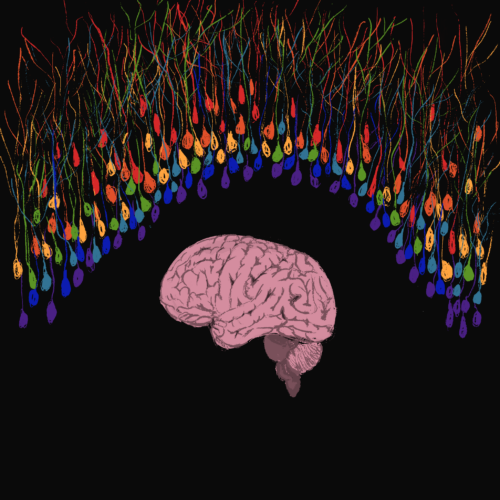Art Courtesy of Kara Tao.
On my desk sits a brain. Until 1984, it was kept in a Brown University neuroscience lab. It’s now found below a wrinkled Scarface poster, illuminated by LEDs. It’s just a plastic model, and the right side of the medulla is broken off a little. But regardless of its idiosyncrasies, it’s a brain. It has a cerebral cortex, tinted pink and indented by the peaks and valleys of gyri and sulci. At its base is its cerebellum, darkened by dense collections of cell bodies. It even has a pineal gland, Descartes’ seat of consciousness, buried deep within the cerebrum.
And that’s almost enough to make you believe, despite its literal plasticity, that electrochemical signals are running around in there, from axon to dendrite, from neuron to neuron. Because it’s those signals that make a collection of gray and white matter a brain. An almost entirely self-contained network of cells that uses electrical messages from our sensory receptors to conceive of a world both external and internal.
We recognize that this consciousness, granted to us by the synapses between neurons, is something sacred. And yet, for millennia, we’ve altered it. When a Tiwanaku shaman, exploring a river valley deep in ancient Bolivia, came across a psilocybin mushroom, his dendrites proliferated, making his nerve networks more intricate than ever before. Receptors typically bound by serotonin were inundated by psychedelics, permanently changing both his synapses and the worlds they created.
But now, we’ve moved beyond chemical alteration. Perspective can dictate whether we’ve shifted to integration or invasion. We’ve invited machines into our neural web, and by doing so, we’ve let them become a part of our consciousness. Functionally both dendrite and axon, electrode arrays can not only receive and process information, but also directly stimulate neighboring neurons through electrical signals, alternately activating and inhibiting their fellow world creators. Abilities previously reserved for biological matter have been ceded to imitations.
Instinct might tell us not to tamper with what we hold sacred. But we, like that early shaman, can be grateful that we don’t give instinct too much power. Because our relationship with these machines is, for now, more mutualistic than parasitic. Their integration with our synapses will give us revolutionary insights into the worlds within that grayish-pink model on my desk. Research into disorders like epilepsy will develop faster than ever before, and the brain’s connection with prosthetic limbs will strengthen dramatically. As long as we don’t surrender ourselves completely to this technology, the changes these machines bring can be for the better.
Artist’s Statement:
When I was young, I read the story of John Henry—the existentialist slave turned railroad worker who gave his life to prove that even in an age of rapid industrialization, man was still greater than machine. When he collapsed from exhaustion, and his victory over steam power turned pyrrhic, I felt angry. I didn’t know it then, but that was the birth of an inherently human distrust for mechanization.
When I grew up, and the stories I encountered began to evolve, I saw the movie Awakenings, based on the work of neuroscientist Oliver Sacks. As I watched him manipulate the neurotransmitters that determine our responses to stimuli, almost to the point of curing an incurable form of encephalitis, I felt a growing attachment to our cells and the signals that produce conscious thought.Somewhat predictably, I’ve always had my suspicions about the brain-machine interface. Reading Song et al.’s article on the newest biocompatible electrode array didn’t change that. But it did make me consider the conflict between the human instinct to cast off the help of machines and the human desire for progress. And now, I’ve started to wonder which impulse’s victory is in our best interests.

